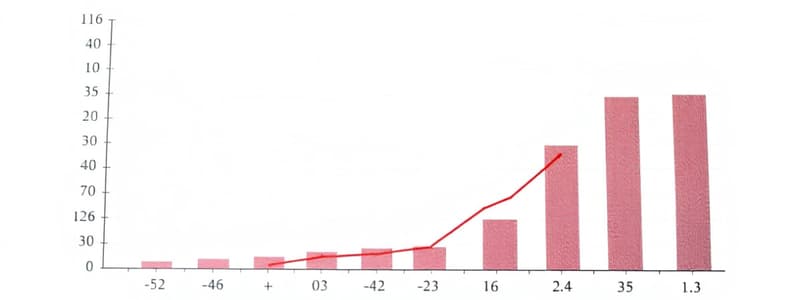Podcast
Questions and Answers
What does the 'F Ratio' in an ANOVA table indicate?
What does the 'F Ratio' in an ANOVA table indicate?
- The number of groups being compared
- The ratio of variation between groups compared to within groups (correct)
- The average of all measurements
- The total variation in the data
What does a low p-value (e.g., less than 0.05) in an ANOVA table suggest?
What does a low p-value (e.g., less than 0.05) in an ANOVA table suggest?
- The group means are similar
- There is no variation in the data
- The sample size is too small
- The differences between group means are likely significant (correct)
In the ANOVA table, what does 'Error' represent?
In the ANOVA table, what does 'Error' represent?
- Other unexplained variability (correct)
- Variation due to sample size
- Variation due to different adhesive types
- The total variation in measurements
How is the Mean Square calculated in an ANOVA table?
How is the Mean Square calculated in an ANOVA table?
What information does the 'Total' row in an ANOVA table provide?
What information does the 'Total' row in an ANOVA table provide?
Which source of variation was found to have a degree of freedom of 4 in the ANOVA table?
Which source of variation was found to have a degree of freedom of 4 in the ANOVA table?
What is suggested by the variation in measurements across different lots of adhesive?
What is suggested by the variation in measurements across different lots of adhesive?
What are the implications of a high F ratio in an ANOVA analysis?
What are the implications of a high F ratio in an ANOVA analysis?
Flashcards
Analysis of Variance (ANOVA)
Analysis of Variance (ANOVA)
A statistical method used to compare the means of two or more groups. It determines if there are significant differences between the groups based on variations in data.
Source (ANOVA)
Source (ANOVA)
Represents the sources of variation in the data. In ANOVA, it typically includes the factor being studied (e.g., different adhesive lots), along with 'error' that captures unexplained variability.
Degrees of Freedom (DF)
Degrees of Freedom (DF)
A measure of the amount of information available in the data to estimate population variances. It's essentially the number of independent pieces of information available in a sample.
Sum of Squares (SS)
Sum of Squares (SS)
Signup and view all the flashcards
Mean Square (MS)
Mean Square (MS)
Signup and view all the flashcards
F Ratio
F Ratio
Signup and view all the flashcards
Prob > F (p-value)
Prob > F (p-value)
Signup and view all the flashcards
Statistical significance (ANOVA)
Statistical significance (ANOVA)
Signup and view all the flashcards
Study Notes
ANOVA Results
- ANOVA results are typically displayed in an ANOVA table.
- The table includes sources of variation: the factor of study (e.g., lot), error, and total.
- Degrees of freedom (DF) are calculated for each source of variation.
- Sum of Squares (SS) represents the sum of squared deviations for each source and overall.
- Mean Square (MS) is the sum of squares divided by its degrees of freedom.
- F-ratio is the mean square of the factor divided by the mean square of error.
- Probability (Prob > F) is the p-value.
Sample ANOVA Table
- A sample ANOVA table displays degrees of freedom, sum of squares, mean squares, F ratios, and p-values for different sources.
- The table shows results for a study with five lots (e.g., lot 1, lot 2, lot 3, lot 4, lot 5) and observations in each lot.
- The results show the mean observation for each lot.
- The p-value (Prob > F) is exceptionally low (0.0012) for the lot, suggesting that the means for different lots are not equal statistically.
Studying That Suits You
Use AI to generate personalized quizzes and flashcards to suit your learning preferences.




